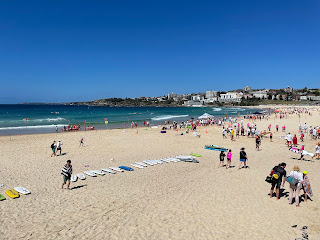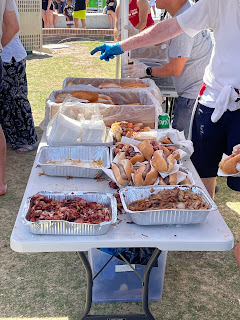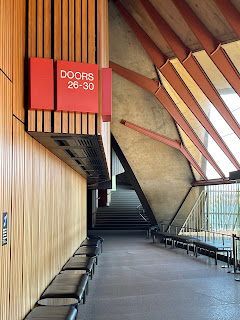Our group walked two blocks to the tram (light rail) stop and rode three stops north to the Royal Botanic Garden. We met a young man of mixed European/aboriginal descent who identifies as a member of the local clan.
He walked us through a small part of this expansive park, mostly talking about how Europeans had changed the landscape and introduced non-native plants.
 |
| A "bottle tree" holds large quantities of water |
He also talked about some of the culture of the indigenous people, and how misunderstandings of each group by the other led to problems and tragedies. He gave us a lot of information about initiation (puberty rites, especially for boys becoming men) and about orality as an information technology.
The talk was supposed to be 45 minutes, but he went on for about 90 minutes. Our guide was upset, but I was not. He was interesting, and we didn't have much else planned for the day.
 |
| These ancient fern/trees are nearly extinct |
Our tour leader took most of the group to a place that creates opal jewelry, ostensibly to learn about opal mining in Australia. But we've been on enough of these trips to know that these sorts of things are 10% education and 90% sales pitch. So, we went our own way.
 |
| Government House -- as close as we got |
We stayed in the Botanic Garden for a while, checking out the Conservatorium of Music (nothing to see there) and the Government House, the historic residence of the Governor of the State of New South Wales (it was closed today).
We did better getting a different view of the Opera House and finding a bench on which to eat lunch and people watch. One hears a lot of Chinese spoken here, but there are tourists from everywhere.
Next we visited the Library of New South Wales. This is a huge public library which is obviously much used by students and others in the community. It's also a museum of sorts, with about a half dozen exhibits from the library's collections and from outside.
The Library and its exhibits are all entirely free, and they are very well done. There was a Shakespeare exhibit, marking the 400th anniversary of the publication of the First Folio (yes, the Library has a copy, as well as a lot of related stuff).
We also spent time in an exhibit of Australian photography, and walked briefly through exhibits of paintings and of indigenous art. We could have easily spent the entire day there, but we had more to see before our legs gave out.
We passed on the opportunity for a free tour of Parliament House, where the legislature of New South Wales meets. The building, while old and historical, is pretty ugly, and a lot of restoration work was underway. We also passed the Mint, largely because it hasn't actually been an actual mint for over 100 years.
Instead, we walked on to the Hyde Park Barracks, which was also free to tour with fancy little headset gizmos that didn't work very well. Nevertheless, it was an interesting exhibit.
The Barracks is one of Sydney's oldest building, constructed with convict labor in 1819 as a barracks for convicts. Sydney began as a prison colony, and prisoners had to be kept somewhere. Conditions here were not great. Apparently there were even more resident rats than convicts. Later, the building had other uses, such as a home for homeless girls and an asylum for the mentally ill.
Across the street from the Barracks is St. James Church. The oldest church in Australia, it was also built with convict labor. It started out to be a courthouse, but was converted mid-construction to be a church. It still functions as an Anglican congregation.
And just down the block is St. Mary's Cathedral, seat of the Roman Catholic Archbishop of Australia. It is much larger and grander than St. James because the original burned down in the mid-1800s and the present structure wasn't completed until 1882, when Australia was much more civilized and prosperous.
Of all the cathedrals in the world that we have seen, this was one of them. It's not very grand. And like many cathedrals, the crypt is more interesting than the nave.
By mid-afternoon we had been on our feet for nearly six hours and had covered more than five miles of browsing and sauntering in museums (which is far more tiring than just plain walking), so we retreated to our hotel room until time for our farewell dinner.
We rode the tram a couple stops, then walked several blocks to Barangaroo, right along Darling Harbour, an area where we hadn't been before. We enjoyed an excellent meal at a Greek restaurant and celebrated the conclusion of the trip. Tomorrow morning we leave for the airport and the long trip home.

















































